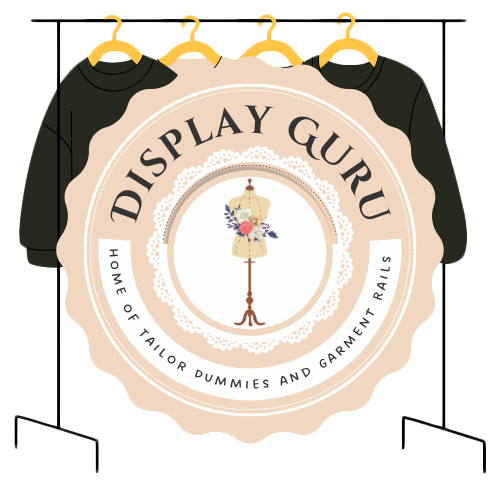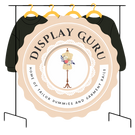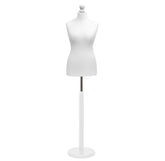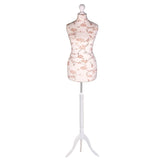Your Guide to a Greetings Card Display Rack Setup
Choosing the right greetings card display rack is far more than a simple storage decision—it’s the first step in creating a space that invites customers to browse, connect, and ultimately, buy. The right display can turn your card collection from a simple product line into a dynamic, profitable focal point for your entire shop.
Choosing the Right Greetings Card Display Rack
Picking the perfect display is a strategic move that directly influences your shop's layout, how easily customers can see your products, and the overall atmosphere you're trying to create. It’s not just about finding something to hold the cards; it’s about finding a unit that actively helps you sell them.
Think about your space first. A cosy, bustling shop with limited floor space needs a completely different solution than a spacious, airy boutique.
Key Display Rack Options
- Spinner Racks: A brilliant solution for tight corners or small retail footprints. They spin, so customers can see dozens of cards without having to move, which is incredibly efficient for packing a lot of variety into a small area.
- Wall-Mounted Units: If you want to keep your floor completely clear, these are the way to go. They create a clean, organised look, almost like a gallery wall, and can transform an otherwise empty space into a money-making feature.
- Tiered Countertop Displays: These are your secret weapon for encouraging impulse buys. Placed right by the till, they're perfect for showcasing seasonal cards, best-sellers, or special offers just as customers are about to pay.
The material of your display also says a lot about your brand. A sturdy metal rack gives off a modern, industrial vibe. Classic wood brings a sense of warmth and tradition. Meanwhile, a sleek acrylic unit feels contemporary and minimalist, letting the card designs themselves do all the talking.
This decision tree can help you visualise the best starting point for your unique layout.
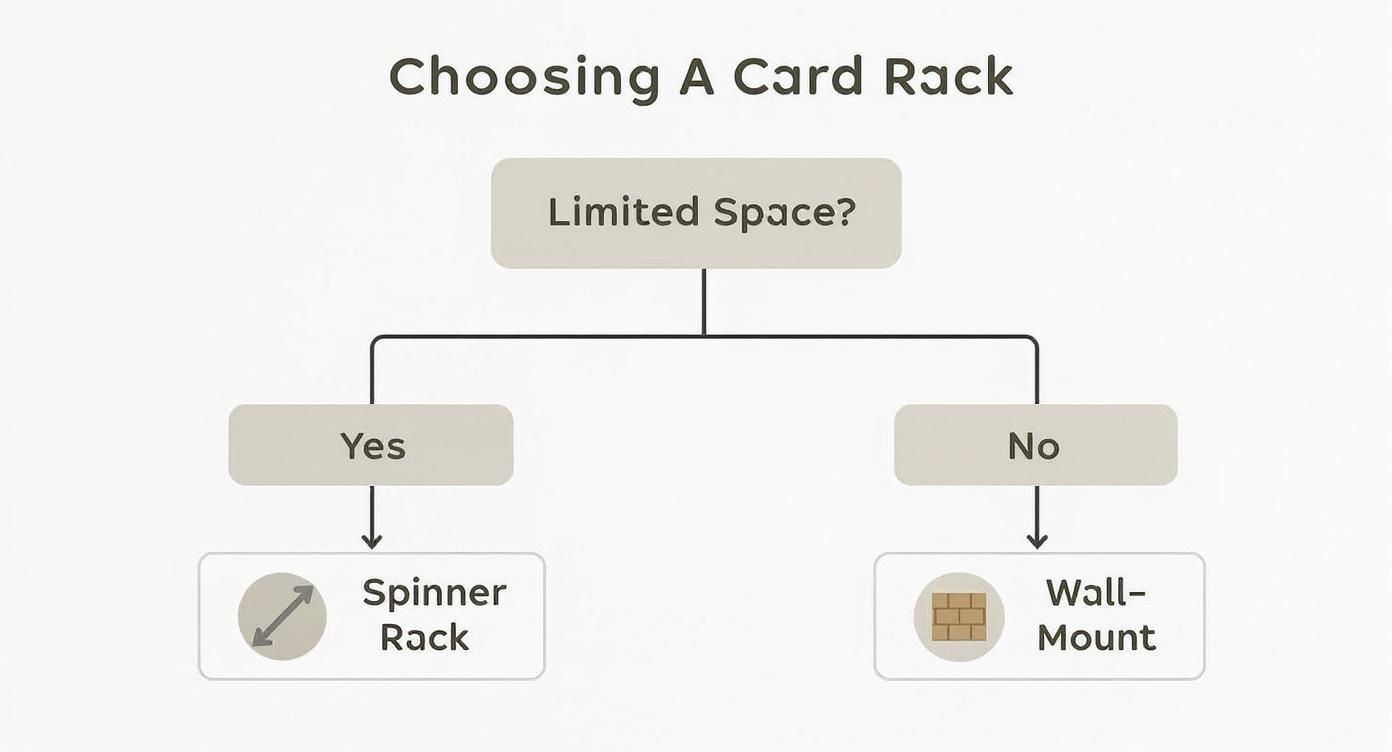
As you can see, your available space is really the first big question to answer, pushing you towards either a spinner or a wall-mounted display. Getting this right is so important, especially when you consider the UK greetings card market is valued at around £1.4 billion each year. Tapping into that huge demand means presenting your cards effectively.
Expert Tip: Always put visibility first. If a customer can't see the full design of a card at a glance, they'll simply move on. Your display pockets should be deep enough to hold cards securely but shallow enough that they don't hide the artwork.
Greetings Card Display Rack Comparison
To help you weigh the options, here’s a quick breakdown of the most common rack types.
| Rack Type | Best For | Pros | Cons |
|---|---|---|---|
| Spinner Rack | Small spaces, high-traffic areas, maximising inventory in a compact footprint. | High capacity for its size; allows 360-degree browsing. | Can feel crowded if overstocked; might not suit a premium aesthetic. |
| Wall-Mounted | Shops with limited floor space, creating a clean, gallery-style display. | Frees up the floor; highly customisable layout; very sleek. | Installation required; fixed capacity once installed. |
| Tiered Countertop | Point-of-sale displays, promoting seasonal cards or best-sellers. | Excellent for impulse buys; small and portable. | Very limited capacity; not suitable for a full range. |
Each style serves a different purpose, so thinking about how your customers move around your shop will point you towards the best fit.
For a deeper dive into the different models and styles available, take a look at our complete guide on greeting card display stands to find the perfect match for your shop's personality.
The Details That Make a Display Rack Truly Work for You
It's easy to get caught up in the style and material of a display, but the small, functional details are what really make a greetings card rack a star performer. These are the features that impact your day-to-day operations, how customers engage with your cards, and ultimately, your bottom line. Think of a well-designed rack not as a piece of furniture, but as a silent salesperson.
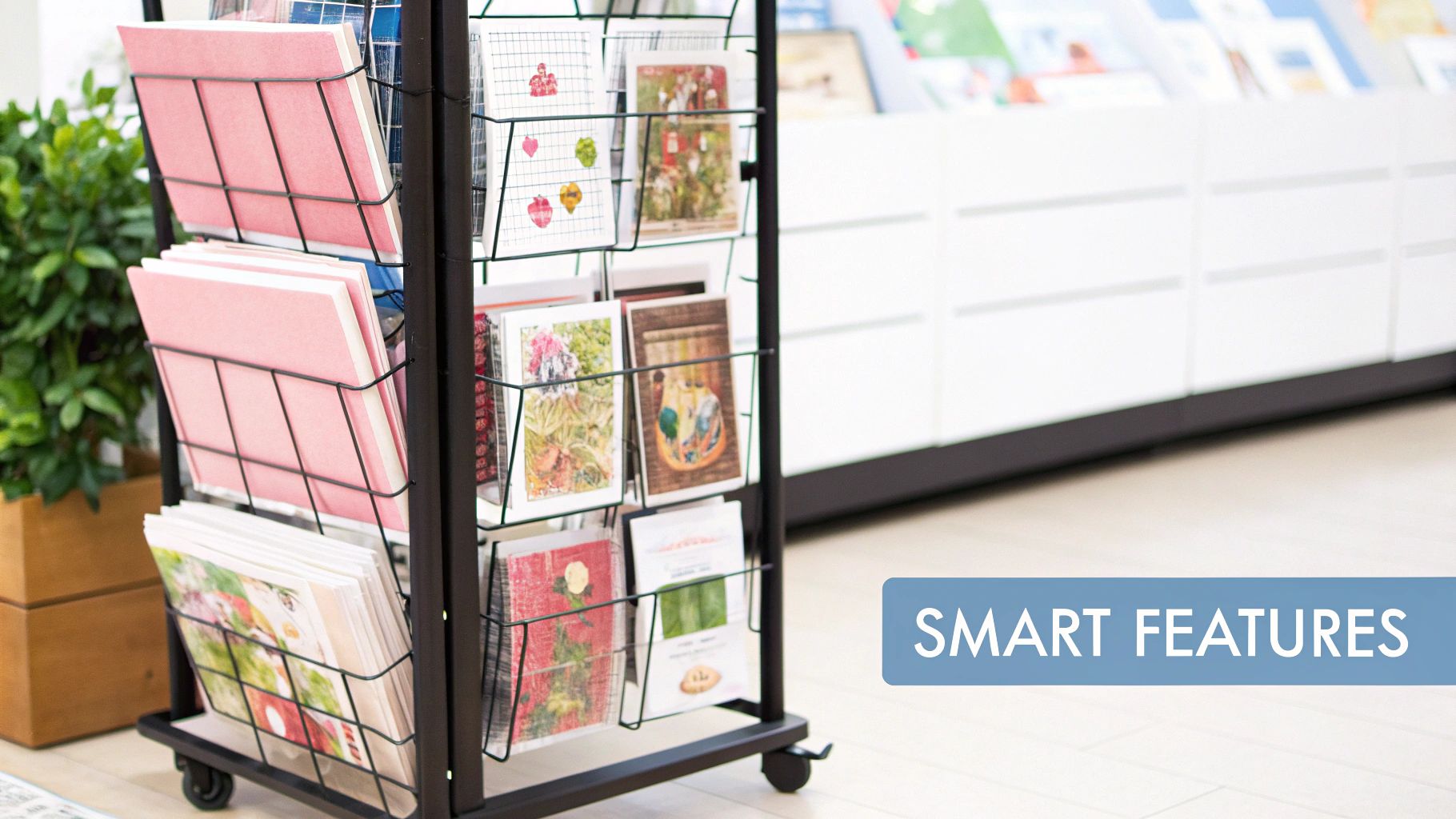
One of the most crucial, yet often overlooked, elements is the pocket design. Always look for a tiered construction. This is where each row sits slightly higher than the one in front, ensuring that every single card is visible and gets its chance to shine.
The depth of those pockets matters immensely, too. Too shallow, and your cards will flop forward all day long. Too deep, and you hide the bottom half of the design, which could be the very part that makes a customer smile and decide to buy. It’s a delicate balance.
Focusing on Adaptability and Solid Construction
Your stock is always in flux, isn't it? One minute you're preparing for the Christmas rush, the next it’s all about Valentine's Day and Mother’s Day. This is where a rack with adjustable or modular parts proves its worth. Being able to reconfigure shelves for different card sizes—from tiny gift tags to larger A4 prints—gives you flexibility that pays off for years to come.
When you're comparing options, keep an eye out for these practical features:
- Robust Build: A greetings card display rack built from quality metal or solid wood is an investment. It needs to handle the bumps and knocks of a busy retail environment without showing its age.
- Easy Mobility: I've found that racks on castors (wheels) are an absolute game-changer. You can effortlessly shift them for floor cleaning, a complete store reshuffle, or even just to test a new, high-traffic spot. No back-breaking work required.
- A Solid Foundation: Nothing puts a customer off faster than a wobbly display. Make sure the rack has a wide, stable base or a weighted stand so it feels secure and safe to browse.
When you invest in a display with these functional features, it starts working for you, not against you. A versatile and sturdy rack doesn't just hold cards; it actively helps you create an attractive, shoppable display that grabs attention.
These core principles don't just stop at cards. To see how the right fixtures can elevate your entire shop floor, have a look at our other guides on effective retail display stands.
Strategic Placement for Maximum Customer Engagement
You’ve got the perfect greetings card display rack; now, where should it live? The spot you pick is just as critical as the rack itself. It's the difference between a display that gathers dust and one that drives sales. This isn't about just filling an empty corner—it's about tapping into the natural flow of your shop and understanding how your customers move.
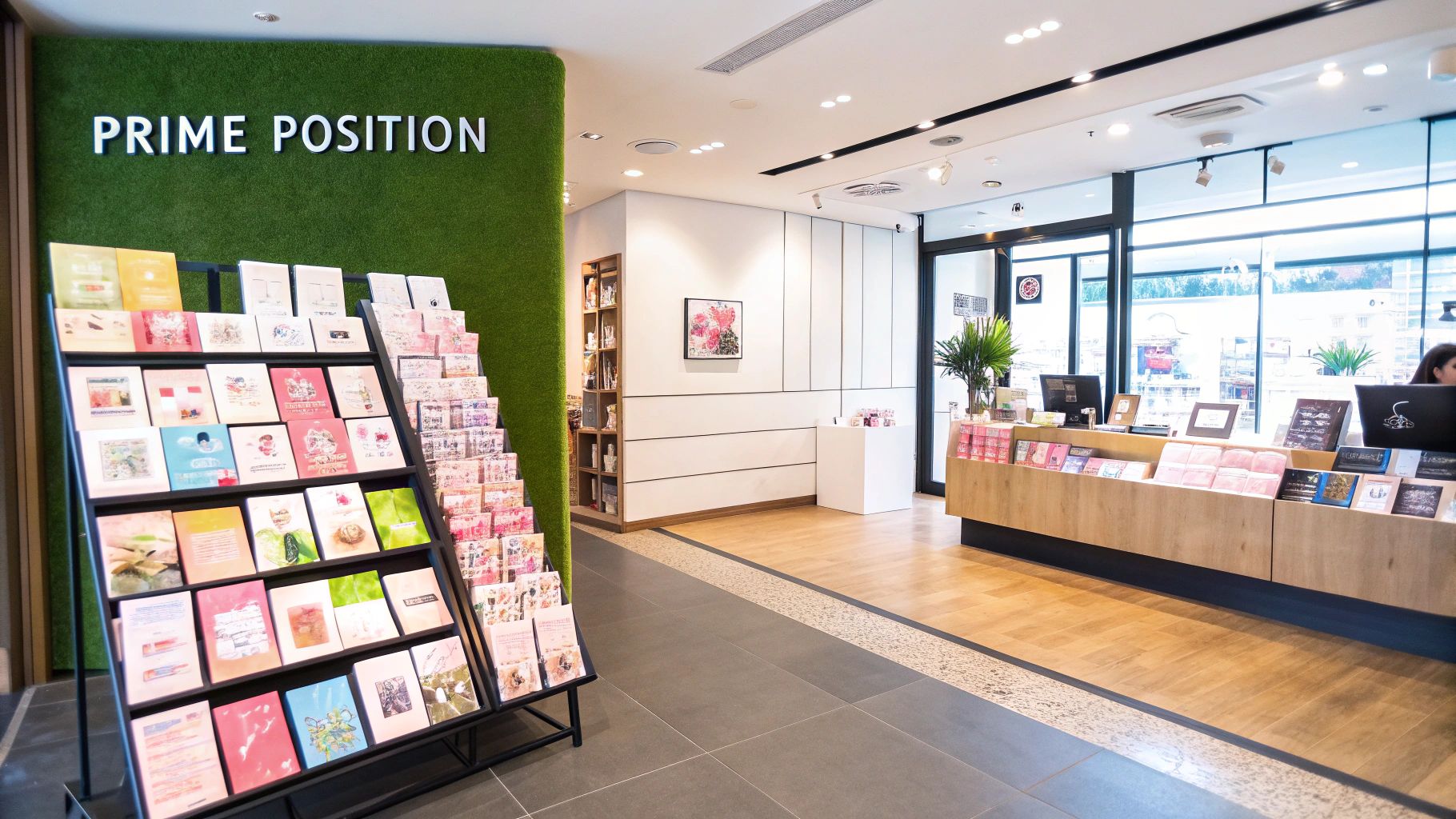
Think about the journey your customers take from the moment they step inside. That first few feet, often called the "decompression zone," is where they shift from the hustle of the outside world to browsing mode. A well-placed display here immediately signals that you sell cards, making it an instant destination.
Another prime piece of real estate is the path leading to your checkout counter. Placing a rack here is a classic move for a reason—it catches people when they're already in a buying mindset. It’s incredibly easy for them to grab a last-minute birthday card or thank-you note while they wait.
Illuminating Your Display for Success
Never underestimate the power of good lighting. A dimly lit rack tucked away in a shadowy corner will be completely overlooked, no matter how lovely the cards are. Your display needs to be a focal point, not a wallflower.
I always recommend using spotlights or dedicated track lighting to really make the display shine. Good lighting draws the eye from across the room and makes the colours and designs on the cards pop.
Think about these high-impact zones for your display:
- Near the Entrance: This captures immediate attention and sets a welcoming tone.
- Alongside Popular Products: If you sell gifts, it’s a no-brainer. Placing your card rack nearby creates an intuitive shopping experience.
- At the End of an Aisle: This creates a natural pause point, encouraging shoppers to stop and browse before turning the corner.
- By the Till Point: An absolute classic for sparking those high-margin, impulse sales.
Your greetings card display should never be an afterthought. By placing it in a high-traffic, well-lit area, you transform it from passive storage into an active, silent salesperson that works for you all day long.
Strategic placement is a cornerstone of effective visual merchandising. For a deeper dive into creating compelling store layouts, you can explore our detailed https://www.displayguru.co.uk/blogs/news/visual-merchandising-guidelines.
Of course, placement is just one part of the puzzle. To really boost how customers interact with your entire store, check out these proven strategies for retail customer engagement. Making your display a deliberate, thoughtful part of your shop’s journey ensures it gets the attention it deserves.
Merchandising Your Cards to Encourage Browsing
A full greetings card display rack is one thing, but a thoughtfully organised one? That’s what stops a customer in their tracks and gets them to start browsing. This is where the real art of visual merchandising comes in, turning a simple rack of cards into a genuinely curated experience.
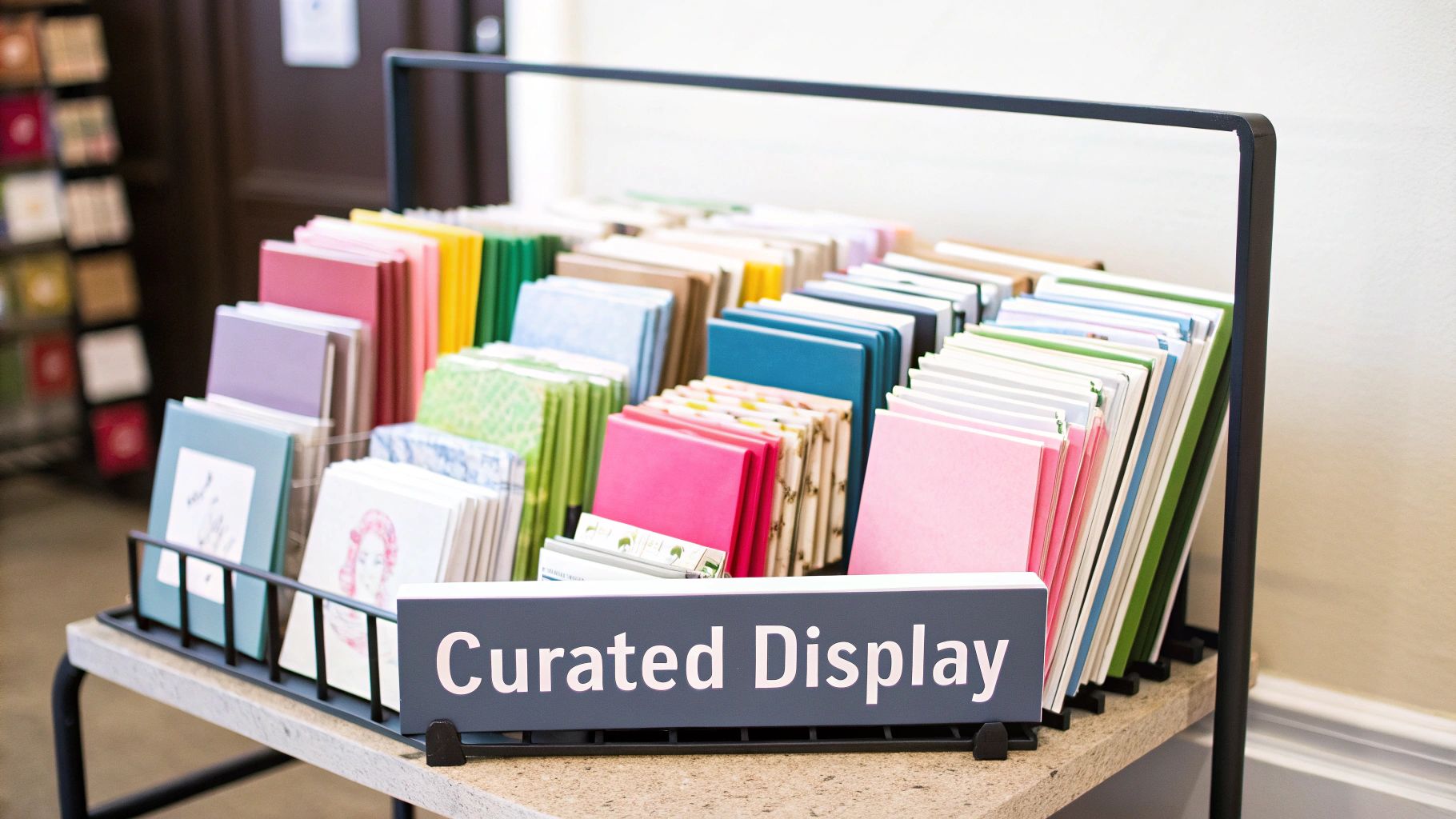
Forget sorting alphabetically; you need to think like your customer. A shopper looking for a birthday card doesn't want to have to sift through a sea of sympathy cards to find what they need. Your goal is to tell a story with your display.
When you organise your cards in a way that makes sense to the buyer, the whole process becomes more intuitive and, frankly, more enjoyable. You’re guiding them right to what they’re looking for. Here are a few grouping strategies I've seen work time and time again:
- By Occasion: This is the classic, go-to method for a reason. Clear sections for birthdays, anniversaries, new babies, and weddings are absolutely essential.
- By Theme: Within those larger occasions, you can create smaller, more niche sections. Think humour, pets, beautiful floral designs, or modern artistic prints. This caters to specific tastes and personalities.
- By Colour: For a really striking visual effect, arranging cards in a colour gradient can be a showstopper. This works particularly well for general-purpose or blank cards where the design is the main selling point.
Keeping Your Display Fresh and Engaging
A display that never changes eventually becomes part of the furniture—regular customers will just walk right past it. The key is to keep things moving. Rotating your stock creates a sense of newness and discovery, giving people a reason to stop and have a proper look each time they visit.
I always recommend a light refresh weekly, maybe swapping out a few designs, and a more significant change-out at least once a month.
With the UK's greeting card import volume recently climbing to 17.8 kilotons, there’s a constant flow of new designs hitting the market. A fresh display signals that you’re on top of the latest trends.
Here's a little trick I've picked up over the years: don’t be afraid to leave a few pockets intentionally empty. A rack that’s packed to the brim can actually feel a bit intimidating to browse. A slightly less full display looks like it’s being actively shopped from, which makes it feel much more approachable and inviting.
Finally, don’t underestimate the power of simple signage. Small, clear signs to label your main sections—"Birthdays," "Thank You," "Just Because"—make a huge difference. You could even go a step further to help customers connect with your products by offering helpful tips or even ideas for what to write in thinking of you cards.
When you start applying these merchandising tips, your display stops being passive storage and becomes an active part of the shopping experience. For more inspiration on making your products pop, check out our other shop display ideas.
Right then, let’s talk about keeping your display looking its best. A dusty, tired-looking rack can really let down the beautiful cards you’ve so carefully chosen. Think of it this way: your display is part of the product presentation. A bit of regular upkeep shows you care and keeps the focus where it belongs – on your brilliant cards.
The material of your rack really determines how you’ll look after it. If you’ve gone for a modern acrylic display, your go-to tools will be a soft microfibre cloth and a gentle, ammonia-free cleaner. Using the right cleaner is key, as anything harsh can cause scratches or that cloudy look that makes a display seem old before its time. A quick spray and wipe once a week is usually enough to keep it gleaming.
Wood and metal displays, on the other hand, need a slightly different touch.
Looking After Wood and Metal Racks
For both wood and metal, a regular dusting is the first and most important step. With wooden racks, you'll want to occasionally treat them with a good quality, wood-safe polish. This simple step helps nourish the timber and keeps that lovely, warm lustre that made you choose it in the first place. Metal racks, particularly the powder-coated ones, are even simpler – just a wipe with a damp cloth gets rid of dust and fingerprints.
A pristine, well-maintained display communicates professionalism and ensures your customers' focus stays exactly where you want it: on your products. It's a small detail that makes a big impact on their perception of your entire shop.
Beyond the regular clean, it’s worth doing a quick once-over every month or so. Just look for any little issues that might be cropping up.
- Wobbly Wheels: Got a mobile rack? Check the castors are clear of any trapped dust or debris and give any loose bolts a quick tighten.
- Bent Pockets: Wire pockets can sometimes get a bit bent out of shape from daily use. Gently ease them back into position so your cards stand up straight and look their best.
Catching these little things early stops them from becoming bigger, more noticeable problems down the line.
Adapting Your Display for Seasons and Trends
Let’s be honest, a greeting card display that never changes eventually just fades into the background. Your regular customers will walk right past it. To keep your selection looking fresh and engaging, you need to sync it up with the calendar and what people are talking about.
Think of your display as a living part of your shop, constantly telling a new story. As spring rolls in, it's time to bring those floral designs, Mother’s Day cards, and Easter themes right to the front. When autumn arrives, the whole mood should shift to warmer colours, Halloween fun, and then, of course, the big build-up to Christmas.
Tuning Into Modern Trends
It's not just about the big holidays anymore. Smart retailers are picking up on what modern shoppers really care about. Why not dedicate a small section of your greeting card display rack to cards from local artists, or those with strong eco-credentials? It’s a brilliant way to attract a very specific and loyal customer.
Cards made from recycled paper or featuring plantable seeds are no longer a niche interest; they’re a significant selling point for a growing number of people.
Even with everything going digital, the classic paper card isn't going anywhere. In fact, here in the UK, traditional cards still account for around 71% of the market's massive £1.4 billion annual revenue. You can dig into the UK greeting card market trends on Grandview Research to see just how strong the demand is. Your physical display is your best tool for meeting that demand head-on.
A dynamic display does more than just sell cards for an upcoming holiday; it gives customers a reason to revisit your shop regularly, creating anticipation for what you'll feature next.
This idea of keeping things fresh shouldn't stop at your card rack. Your shop window needs to give passers-by a taste of what's new and exciting inside. Applying these seasonal principles is just one of many effective window display ideas to attract customers.
By creating a simple schedule for changing things up, you ensure your card selection always feels relevant. This encourages those brilliant impulse buys and makes your shop the go-to place for people hunting for that perfect, timely card.
Got Questions? We've Got Answers
Over the years, I've heard pretty much every question there is about displaying greeting cards. Retailers often run into the same challenges, so I've put together some straightforward advice for the most common queries I get.
I've Got a Small Shop, What's the Best Rack for Me?
When you're short on space, the only way to go is up. Think vertically. A slim, multi-tiered wall-mounted rack is a brilliant option because it takes up precisely zero floor space. This keeps your shop feeling open and easy to navigate.
Another great choice is a tall, rotating spinner rack. They pack a huge number of cards into a tiny footprint, making it dead simple for customers to flick through your entire collection without taking up valuable aisle room.
How Often Should I Be Changing My Card Display?
My rule of thumb? Give it a quick refresh every week. I'm not talking about a massive overhaul, just a simple tidy-up. Straighten the cards in their pockets, fill in any gaps, and maybe bring a few different designs to the front. It keeps the display looking cared for and interesting.
You'll want to do a proper re-merchandise at least once a month, though. This is your chance to tie in with seasonal events like Mother's Day or Christmas, or simply to show off your newest arrivals. It’s a small habit that makes a big difference for your regulars.
Will a Better Display Rack Actually Increase My Sales?
Without a doubt. A great display isn't just about looking good; it's about making it effortless for people to buy from you. A well-organised rack makes your cards pop, simplifies browsing, and just gives your whole setup a more professional feel.
Think about it from a customer's perspective. If they can easily see what you've got and find the perfect card without a struggle, they're far more likely to head to the till. It’s that simple.
Ready to find the perfect display solution to boost your card sales? Display Guru can help. Take a look at our full range of professional retail displays over at https://www.displayguru.co.uk.
